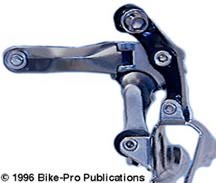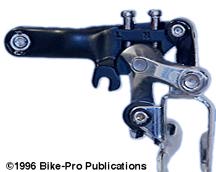
There have been a few changes in front derailleurs in the last few years. The new compact cranks, Micro Drive and HyperDrive-C have allowed the Front derailleur cage to shorten and made it a more tightly radiused arc. The cages have also been brought more in-board toward the frame to work with the new low profile cranks. The front derailleur's job is to nudge the chain from one of the front chainrings to another, as smoothly as possible. In the early days of front changers, (as they are known by enthusiasts) the mechanism's return spring was an oversized, flat, coiled, inner watch type mainspring. Those days ended in the middle of the 1960's when the more common round coiled spring came into use. At the time of the flat spring, the front derailleur had no provision built into it to lift the chain up to a larger chainring. It merely used the front derailleur cage to shove the chain laterally in a straight line to and from the chainrings. This style had a tremendous lag in engaging on the bigger chainrings, though it worked somewhat better, from the large to small chainrings. The improvement on this style incorporated a cantilevered scissor system to lift the chain as it moved from the small to the large chainrings. This, the Japanese innovated and perfected, calling it the "slant pantagraph" design. Using a scissored design, as the cage moves away from the bike it also moves upward to lift the chain to the larger chainring. As it moves back in it also moves down. Oversized clamps on front derailleurs is now common. If you have an aluminum frame, you'll already understand. In order to get aluminum alloy to achieve the same strength to weight ratio as a steel frame, you must make the aluminum tubing with a considerably thicker wall than would be needed for a steel tube. Not only must you make it thicker, but the tube must be made much larger in diameter to be strong enough. The dimension of aluminum seat tube is 1 1/4" or 1 3/8" rather the standard 1 1/8". Nearly all Titanium frames have a 1 1/4" or 1 3/8" seat tube, using a larger diameter and a thinner wall. These bigger sizes also begin explain the move toward oversized seatpost diameters. Some frames don't permit the use of a clamp (also known as a band) to hold the front derailleur on. Instead they rely on a steel bracket with a contoured back. On the traditional steel frame these brackets are brazed onto the frame, hence this type of mounting style has become known as a "braze-on" mount. In aluminum and carbon fiber frames the brackets are held to the frame with recessed nutserts, though still referred to as "braze-ons", are generally epoxy bonded onto the frame. Front derailleurs have a rating known as "capacity". Capacity is a rating for the difference in the number of teeth between the chainring sizes. If the "capacity" of the front derailleur was 14 teeth, the difference between the largest and smallest chainring sizes must be 14 teeth or less. For example, if you had a road racing double crankset that was 52-40 (52 teeth for the large outer one and 40 teeth for the small inner), we would find that 52 minus 40 is equal to 12, we have a 12 tooth difference between the two chainrings. Because 12 is less than the 14 tooth "capacity" of the front derailleur, it would work with no difficulty. If, however, it were a 54-36 crankset the result would be (54 minus 36=18) 18 and this would exceed the front derailleur's "capacity". The front changer couldn't lift the chain comfortably to the large chainring. In the case of a triple crankset, the same principle applies, however you would use the difference between the outermost and the innermost chainring.


There is a desire, for avid mountain bikers to have "top pull" front derailleurs. Top Pull is used to describe a front derailleur that has the cable routed across the top tube and down the back side of the seat tube. It is then fastened to the pin anchor bolt (the nut and bolt that holds the cable) without passing under or near the bottom bracket. It is literally pulled from the top rather than from under the B/B or a pulley on the back of the seat tube. There are two reasons why this has become more popular. First, with bottom routing dirt, mud and debris get caught in the cable under the B/B shell. Secondly, the shorter you make the derailleur cable the more swiftly you will get the derailleur to work. Top pull routing produces a shorter cable with less turns so the derailleur responds to your shift quickly. It adds a surefootedness to any premium bike, and is available as a feature only on Mountain front derailleurs. To be compatible for Top Pull routing the frame must have a cable stop high on the back of the seat tube There are still some riders that believe that the use of one particular index shifting system obligates them to use that manufactures front derailleurs. And certainly the derailleur/shift maker wants you to think that only their parts work with each other, but it's just not true. The index shift mechanism resides entirely in the shifter/shift lever set, and this is easy to demonstrate by grasping the front derailleur and forcing the cage to extend outward. You'll notice that there are no "clicks" as it moves smoothly away, as though it were shifting to a larger chainring. The "click" or "detent" is a part of the shift lever. Now that the industry has established that rear cogs will be 1.8mm thick and there will be 3.0mm of space between each, all front derailleurs will work with any shift system. The chosen derailleur should have the same chainring range. A "compact" mountain crankset front derailleur, either Micro-Drive or HyperDrive-C, will not work with a standard geared mountain crankset that requires a larger capacity. But you should shop for a front derailleur based on anything other than the shift system it is supposedly "mated" to. Finally, all the front derailleurs we sell come with installation instructions, that are printed in several languages.
